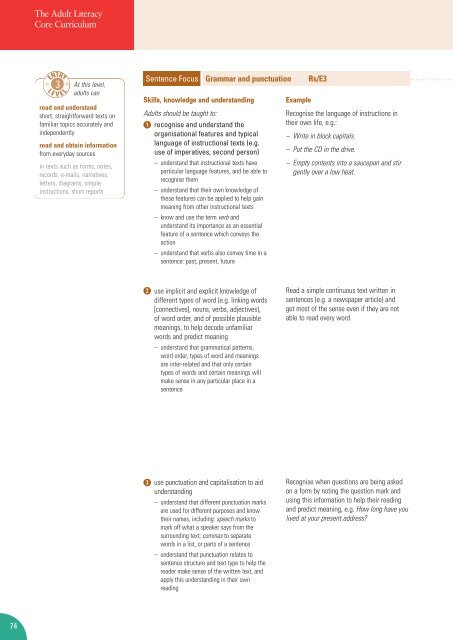Adult Literacy Core Curriculum - Nationally developed Skills for Life ...
Adult Literacy Core Curriculum - Nationally developed Skills for Life ...
Adult Literacy Core Curriculum - Nationally developed Skills for Life ...
You also want an ePaper? Increase the reach of your titles
YUMPU automatically turns print PDFs into web optimized ePapers that Google loves.
74<br />
The <strong>Adult</strong> <strong>Literacy</strong><br />
<strong>Core</strong> <strong>Curriculum</strong><br />
At this level,<br />
adults can<br />
read and understand<br />
short, straight<strong>for</strong>ward texts on<br />
familiar topics accurately and<br />
independently<br />
read and obtain in<strong>for</strong>mation<br />
from everyday sources<br />
in texts such as <strong>for</strong>ms, notes,<br />
records, e-mails, narratives,<br />
letters, diagrams, simple<br />
instructions, short reports<br />
Sentence Focus Grammar and punctuation Rs/E3<br />
<strong>Skills</strong>, knowledge and understanding<br />
<strong>Adult</strong>s should be taught to:<br />
1 recognise and understand the<br />
organisational features and typical<br />
language of instructional texts (e.g.<br />
use of imperatives, second person)<br />
– understand that instructional texts have<br />
particular language features, and be able to<br />
recognise them<br />
– understand that their own knowledge of<br />
these features can be applied to help gain<br />
meaning from other instructional texts<br />
– know and use the term verb and<br />
understand its importance as an essential<br />
feature of a sentence which conveys the<br />
action<br />
– understand that verbs also convey time in a<br />
sentence: past, present, future<br />
2<br />
3<br />
use implicit and explicit knowledge of<br />
different types of word (e.g. linking words<br />
[connectives], nouns, verbs, adjectives),<br />
of word order, and of possible plausible<br />
meanings, to help decode unfamiliar<br />
words and predict meaning<br />
– understand that grammatical patterns,<br />
word order, types of word and meanings<br />
are inter-related and that only certain<br />
types of words and certain meanings will<br />
make sense in any particular place in a<br />
sentence<br />
use punctuation and capitalisation to aid<br />
understanding<br />
– understand that different punctuation marks<br />
are used <strong>for</strong> different purposes and know<br />
their names, including: speech marks to<br />
mark off what a speaker says from the<br />
surrounding text; commas to separate<br />
words in a list, or parts of a sentence<br />
– understand that punctuation relates to<br />
sentence structure and text type to help the<br />
reader make sense of the written text, and<br />
apply this understanding in their own<br />
reading<br />
Example<br />
Recognise the language of instructions in<br />
their own life, e.g.:<br />
– Write in block capitals.<br />
– Put the CD in the drive.<br />
– Empty contents into a saucepan and stir<br />
gently over a low heat.<br />
Read a simple continuous text written in<br />
sentences (e.g. a newspaper article) and<br />
get most of the sense even if they are not<br />
able to read every word.<br />
Recognise when questions are being asked<br />
on a <strong>for</strong>m by noting the question mark and<br />
using this in<strong>for</strong>mation to help their reading<br />
and predict meaning, e.g. How long have you<br />
lived at your present address?

















